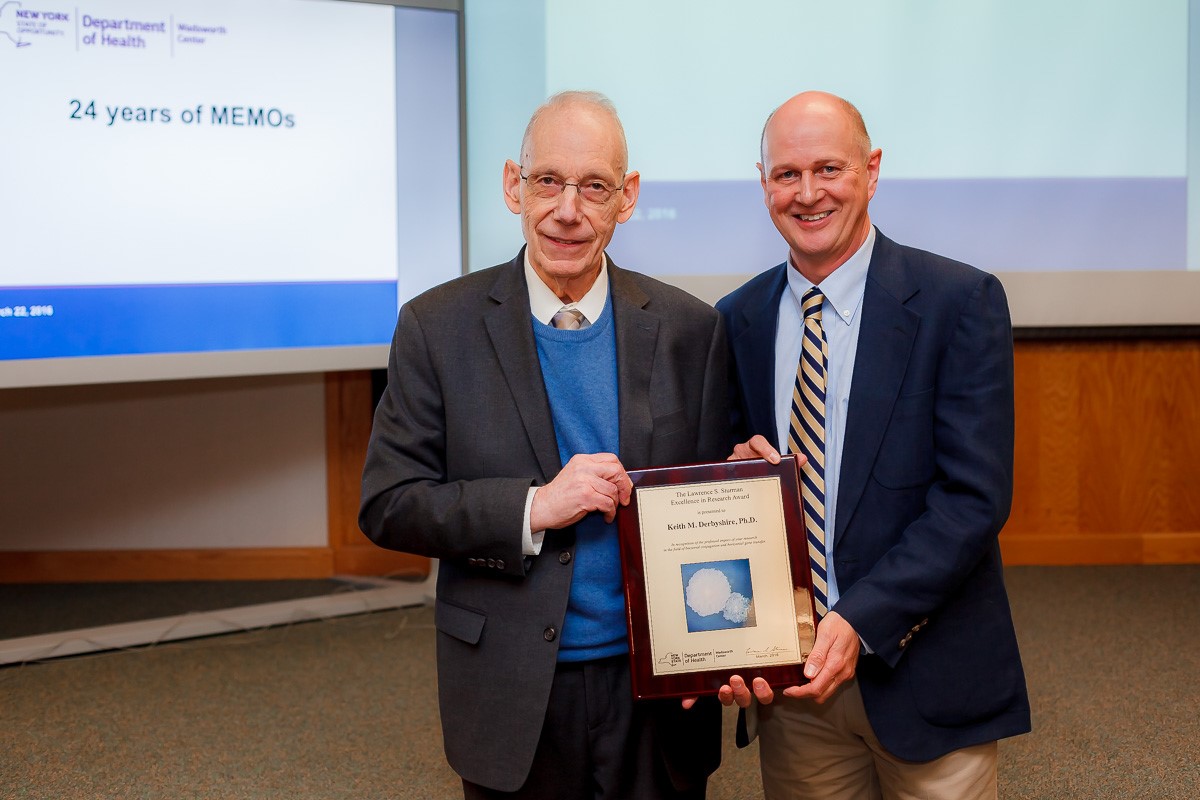
Twenty-four years at the Wadsworth Center have given Keith Derbyshire, Ph.D., a career’s worth of MEMOs. Not the interoffice paper shuffle made obsolete by email and text messages, but a laboratory dedicated to MEMOs – Mobile Elements in Micro-Organisms.
That was the name he and his colleagues gave their laboratory in 1992, when they were beginning their research in bacterial conjugation and horizontal gene transfer – mechanisms that move DNA both within and between cells. Derbyshire applied his findings to the genus Mycobacterium, which includes the major human pathogens Mycobacterium tuberculosis and Mycobacterium leprae, causative agents of tuberculosis and leprosy, respectively. He has become an expert in the genetics of the molecules and processes that make M. tuberculosis such a successful pathogen.
Now the Wadsworth Center has honored Derbyshire, Director of its Division of Genetics, with the 2016 Lawrence S. Sturman Excellence in Research Award, established in 2012 to recognize outstanding achievement among the Wadsworth Center community of biological or environmental scientists. The award, named for Wadsworth’s Director Emeritus, was presented to Derbyshire by Dr. Sturman in a recent ceremony at the Wadsworth Center.
 |
|
|
In accepting the award, Derbyshire gave a talk about those mobile elements in micro-organisms entitled, “24 Years of MEMOs.” While most of us have seen plastic models or computer graphics showing the DNA helix as unyielding, Derbyshire’s research has shown that the genes within bacteria can move within and between cells and, as a consequence, alter the genetic makeup of those cells.
The genes that move around in the genome are colloquially referred to as “jumping genes,” but their formal name is transposons, and their movement is called bacterial transposition. Derbyshire’s work has added greatly to the scientific understanding of how transposons move, which is important because transposons often contain genes encoding resistance to antibiotics, and their movement can spread the resistance genes to other antibiotic-sensitive bacteria.
More recently, Derbyshire’s work delved into distributive conjugal transfer (DCT), a form of DNA transfer between bacterial cells that results in a blending of parental DNA, which is more extensive than that obtained through transposition. Both bacterial transposition and DCT are ways of increasing genetic diversity, which increases an organism’s odds of survival in a changing environment – by making them more virulent or enhancing resistance to antibiotics, for example.
Derbyshire’s most recent projects have demonstrated that the way proteins – the main functional and structural molecules in the cell - get made in mycobacteria, is different from the way proteins get made in E. coli, which, to-date, had been the scientific model for understanding such processes. More specifically, he discovered that mycobacteria encode many “leaderless transcripts,” or RNAs that lack the traditional signals to be turned into protein, thus bringing into question how these leaderless transcripts are recognized and efficiently translated into active proteins. Unexpectedly, the work also revealed that mycobacteria encode many proteins that are much smaller in size than other proteins, so small they had been previously overlooked, and are not found in other bacteria. “Together, this work will help us understand gene structure, genome organization and protein expression in bacteria and determine how the translational machinery differs in different organisms,” Dr. Derbyshire said.
These leaderless transcripts and small proteins are “the tip of the iceberg” that could transform our understanding of how pathogens build and mutate, Derbyshire said. The role of small proteins in pathogens has been mostly unexplored, and raises new possibilities for research in determining their function. One possibility Dr. Derbyshire’s laboratory is investigating is that these small proteins may regulate larger proteins in response to the many external factors that mycobacteria are exposed to in the environment and during infection.
Derbyshire emphasized the significant contributions to his work by the entire Wadsworth community, an environment where public health and research laboratories inhabit the same hallways, and ideas and information flow back and forth. His research benefited from the hard work of people in the Applied Genomic Technologies Core, the Bioinformatics Core, and the contributions of Drs. Joe Wade and Todd Gray and their staffs.
A sign posted by the MEMO laboratory over 20 years ago referenced a “paradigm shift.” The word “non-canonical” is used repeatedly in Derbyshire’s most recent paper.
Paradigm, the model. Canon, the rule.
All these years later, Derbyshire continues to think outside the box, in ways other than the accepted rule or pattern, in ways that demonstrate excellence in research.
Related link: